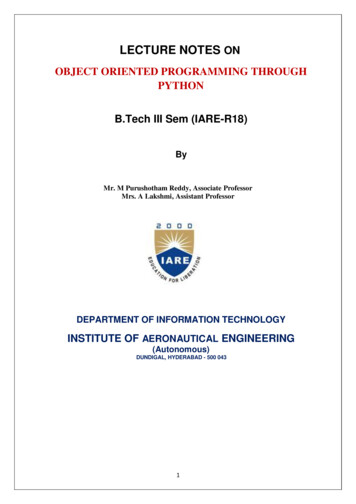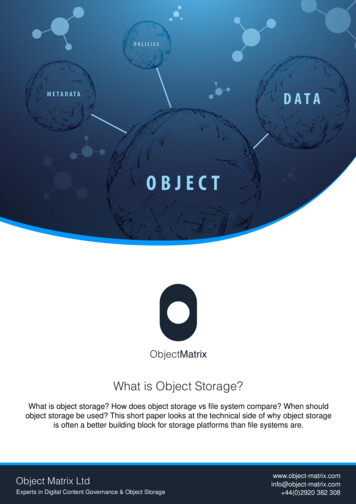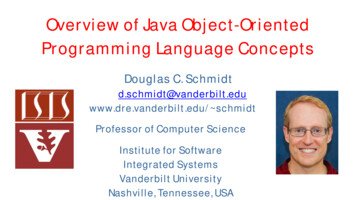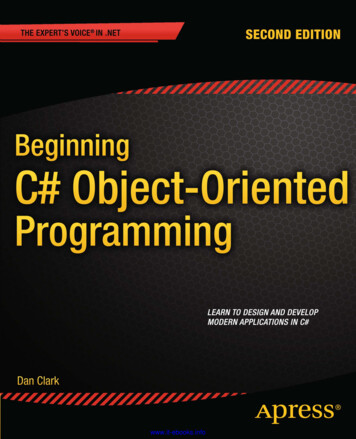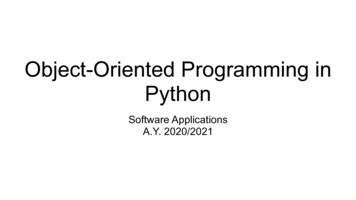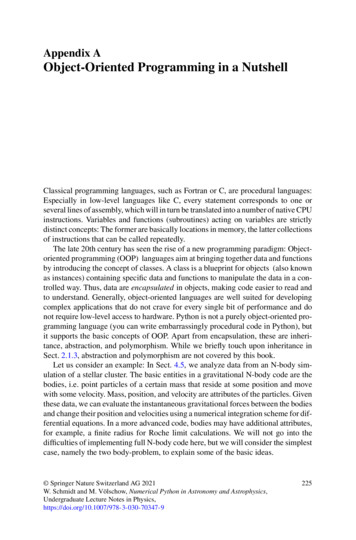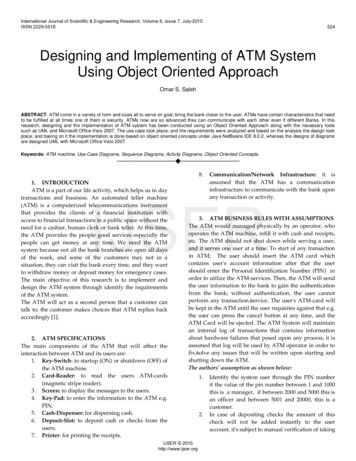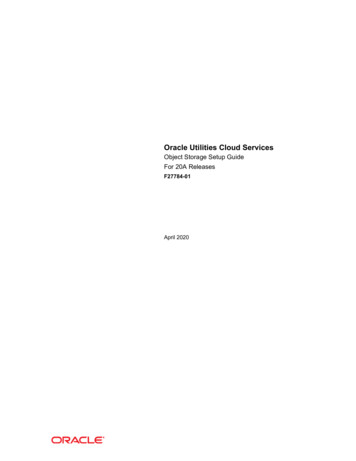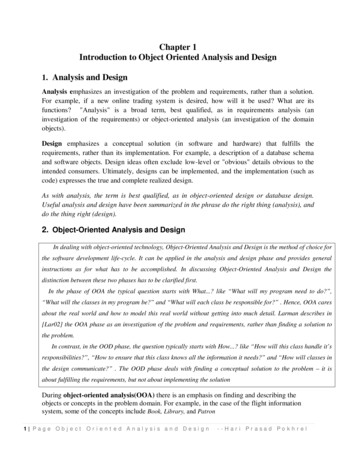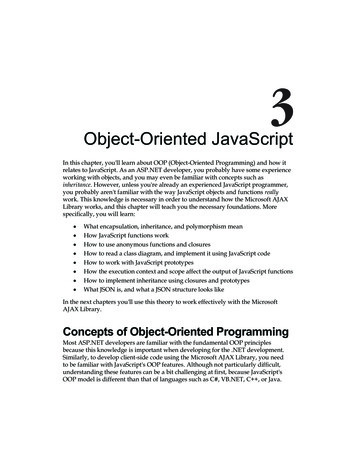
Transcription
2
OBJECT-ORIENTED IMPLEMENTATION OF OPTION PRICING VIA MATLAB:MONTE CARLO APPROACHA THESIS SUBMITTED TOTHE GRADUATE SCHOOL OF APPLIED MATHEMATICSOFMIDDLE EAST TECHNICAL UNIVERSITYBYÖZGE TEKİNIN PARTIAL FULFILLMENT OF THE REQUIREMENTSFORTHE DEGREE OF MASTER OF SCIENCEINFINANCIAL MATHEMATICSJULY 2015
Approval of the thesis:OBJECT-ORIENTED IMPLEMENTATION OF OPTION PRICING VIAMATLAB: MONTE CARLO APPROACHsubmitted by ÖZGE TEKİN in partial fulfillment of the requirements for the degree of Master of Science in Department of Financial Mathematics, Middle EastTechnical University by,Prof. Dr. Bülent KarasözenDirector, Graduate School of Applied MathematicsAssoc. Prof. Dr. Ali Devin SezerHead of Department, Financial MathematicsAssoc. Prof. Dr. Ömür UğurSupervisor, Scientific ComputingAssoc. Prof. Dr. Yeliz Yolcu OkurCo-supervisor, Financial MathematicsExamining Committee Members:Assoc. Prof. Dr. Ömür UğurScientific Computing, METUProf. Dr. Gerhard Wilhelm WeberScientific Computing, METUAssoc. Prof. Dr. Ümit AksoyDepartment of Mathematics, Atılım UniversityDate:
I hereby declare that all information in this document has been obtained andpresented in accordance with academic rules and ethical conduct. I also declarethat, as required by these rules and conduct, I have fully cited and referenced allmaterial and results that are not original to this work.Name, Last Name: ÖZGE TEKİNSignaturev:
vi
ABSTRACTOBJECT-ORIENTED IMPLEMENTATION OF OPTION PRICING VIA MATLAB:MONTE CARLO APPROACHTekin, ÖzgeM.S., Department of Financial MathematicsSupervisor: Assoc. Prof. Dr. Ömür UğurCo-Supervisor: Assoc. Prof. Dr. Yeliz Yolcu OkurJuly 2015, 69 pagesThere are many applications in finance and investment that require the use of methods,which involve time-consuming and laborious iterative calculations. Although closedform solutions are available for some specific instruments, the valuation methods usedin financial engineering in many other situations require analytical methods, whichcompute approximate solutions on computing environments.Option pricing is one of the most important and active topics in financial engineering, and there are many fundamental methods for numerous different type options inliterature as well as in the derivative market. Close investigation of options shows, besides the underlying parameters, significant relation and similarities, even inheritance,such as options on options. On the other hand, investigation of the valuation methodsreveals the use of similar fundamental algorithms, such as Monte Carlo technique orsolving the corresponding partial differential equation.Therefore, a software environment for pricing financial derivatives should be as flexibleas possible to modify and extend the options as well as methods for pricing them.Object-oriented principles and modeling techniques, which contains analysis, designand implementation, have to be utilized for such a goal. After having analyzed optionsand pricing methods, the classes and subclasses to design a hierarchy that forms thestructure of those options and methods are to be organized. As the relation betweenclasses is so tight that each individual unit, objects, must be qualified to sending orvii
receiving information to other objects while being responsible for their own work.Many modern object-oriented programming languages are transferable from one toanother. Hence, M ATLAB R is preferred in this study as it provides numerous built-infunctions and is a very suitable platform to develop OOP based softwares.Keywords : Object-Oriented Programming, Monte Carlo Methods, Option Pricingviii
ÖZOPSİYON FİYATLANDIRMASININ NESNE YÖNELİMLİ MATLABUYGULAMASI: MONTE CARLO YÖNTEMİTekin, ÖzgeYüksek Lisans, Finansal Matematik BölümüTez Yöneticisi: Doç. Dr. Ömür UğurOrtak Tez Yöneticisi: Doç. Dr. Yeliz Yolcu OkurTemmuz 2015, 69 sayfaFinans ve yatırım alanlarında zaman alan ve zorlu yinelemeli hesaplar içeren yöntemlerin kullanımını gerektiren birçok uygulama vardır. Finans mühendisliğinde belirlitürev ürünler için kapalı-form çözümler olmasına rağmen, birçok durumda hesaplamayöntemleri yaklaşık çözümleri bilgisayar ortamında hesaplayan analitik yöntemler gerekmektedir.Opsiyon fiyatlama, finans mühendisliğindeki en önemli ve aktif konulardan birisidirve literatürde çeşitli opsiyonları fiyatlandırmak için birçok temel yöntem bulunmaktadır. Opsiyonlar ve bağlı oldukları parametreler yakından incelendiğinde, opsiyonlarüzerine yazılan opsiyonlar gibi, oldukça önemli bağıntı ve benzerlikler, hatta kalıtımilişkisi gözlemlenir. Bununla birlikte, fiyatlama yöntemleri incelendiğinde Monte Carlotekniği ve karşılık gelen kısmi diferansiyel denklem çözümü gibi benzer temel algoritmaların kullanıldığı görülmüştür.Bu sebeple, finansal türev araçları fiyatlandırmak için oluşturulan yazılım ortamı, opsiyonları ve fiyatlama tekniklerini yeniden düzenlemek ve genişletmek için mümkünolduğunca esnek olmalıdır. Analiz, tasarım ve uygulama basamaklarını içeren nesneyönelimli ilkeler ve modelleme teknikleri bu amaç için kullanılmaktadır. Opsiyon vefiyatlama tekniklerini analiz ettikten sonra bu opsiyonların yapısını oluşturan hiyerarşiyi tasarlamak için sınıflar ve alt sınıflar organize edilmiştir. Sınıflar arasındaki ilişkioldukça sıkıdır ve her bağımsız birim yani nesne kendi işleyişinden sorumluyken diğerix
nesnelerle bilgi alışverişini gerçekleştirir. Birçok nesne yönelimli programlama dilibirbirine dönüştürülebilir. Sağladığı hazır fonksiyonlar ve nesne yönelimli programlama için uygun olması sebebiyle bu çalışmada M ATLAB R programlama dili tercihedilmiştir.Anahtar Kelimeler : Nesne Yönelimli Programlama, Monte Carlo Yöntemi, OpsiyonFiyatlamax
To my parentsandmy love Ulaşxi
xii
ACKNOWLEDGMENTSFirst of all, I would like to express my very great appreciation to my thesis supervisorAssoc. Prof. Dr. Ömür Uğur and co-supervisor Assoc. Prof. Dr Yeliz Yolcu Okur fortheir patient guidance, encouragement and invaluable advices not only throughout thedevelopment and preparation of this thesis but also my graduate education so far.I would like to thank the members of my thesis committee, Prof. Dr. Gerhard WilhelmWeber and Assoc. Prof. Dr. Ümit Aksoy for their valuable comments and insight.I deeply thank all members of the Institute of Applied Mathematics (IAM) for providing a helpful and sincere environment. Additionally, my special thank goes to members of room S206, Cansu Evcin, Sinem Kozpınar, Neşe Öztop, Ayşe Sarıaydın, AhmetSınak, Meral Şimşek and Büşra Temoçin for their kindness, friendship and support.Finally, none of my studies would have been possible without the support of mybeloved ones. I would like to express my gratefulness to my parents for their continuous support, encouragement, endless love and understanding in all aspects of mylife. Also, I would like to thank my significant other, Ulaş, for his full support, encouragement, patience and love. I have been extremely lucky to have them.xiii
xiv
TABLE OF CONTENTSABSTRACT . . . . . . . . . . . . . . . . . . . . . . . . . . . . . . . . . . . .viiÖZ . . . . . . . . . . . . . . . . . . . . . . . . . . . . . . . . . . . . . . . . .ixACKNOWLEDGMENTS . . . . . . . . . . . . . . . . . . . . . . . . . . . . .xiiiTABLE OF CONTENTS . . . . . . . . . . . . . . . . . . . . . . . . . . . . .xvLIST OF FIGURES . . . . . . . . . . . . . . . . . . . . . . . . . . . . . . . .xixLIST OF TABLES . . . . . . . . . . . . . . . . . . . . . . . . . . . . . . . .xxiLIST OF ABBREVIATIONS . . . . . . . . . . . . . . . . . . . . . . . . . . . xxiiiCHAPTERS12INTRODUCTION . . . . . . . . . . . . . . . . . . . . . . . . . . .11.1Aim of the Thesis . . . . . . . . . . . . . . . . . . . . . . .11.2Literature Review . . . . . . . . . . . . . . . . . . . . . . .11.3Structure of the Thesis . . . . . . . . . . . . . . . . . . . . .3PRELIMINARIES . . . . . . . . . . . . . . . . . . . . . . . . . . .52.1Options . . . . . . . . . . . . . . . . . . . . . . . . . . . . .52.1.1Plain-Vanilla Options . . . . . . . . . . . . . . . .62.1.2Barrier Options . . . . . . . . . . . . . . . . . . .72.2Option Strategies . . . . . . . . . . . . . . . . . . . . . . .92.3Stochastic Differential Equations with Jumps . . . . . . . . .10xv
2.3.1Stochastic Differential Equations and Itô Process .112.3.2Black Scholes Framework . . . . . . . . . . . . .132.3.3Pure Jump Processes . . . . . . . . . . . . . . . .172.3.3.1Poisson Process . . . . . . . . . . . .172.3.3.2Compound Poisson Process . . . . . .182.3.3.3Compensated Poisson and CompensatedCompound Poisson Processes . . . . . 192.3.4Jump Diffusion Models . . . . . . . . . . . . . . .21Monte Carlo Approach . . . . . . . . . . . . . . . . . . . .232.4.1Crude Monte Carlo Approach . . . . . . . . . . .232.4.2Implementation of Monte Carlo Approach to European Option Pricing . . . . . . . . . . . . . . . . .242.4.2.1Numerical Solution . . . . . . . . . .25OBJECT-ORIENTED PROGRAMMING . . . . . . . . . . . . . . .273.1What is the OOP? . . . . . . . . . . . . . . . . . . . . . . .273.1.1Class and Object . . . . . . . . . . . . . . . . . .28Concepts of the OOP . . . . . . . . . . . . . . . . . . . . .293.2.1Abstraction . . . . . . . . . . . . . . . . . . . . .293.2.2Encapsulation . . . . . . . . . . . . . . . . . . . .293.2.3Inheritance . . . . . . . . . . . . . . . . . . . . .303.2.4Polymorphism . . . . . . . . . . . . . . . . . . .31The Unified Modeling Language (UML) . . . . . . . . . . .32DESIGN AND IMPLEMENTATION OF OOMCOP . . . . . . . . .372.433.23.344.1OOP in M ATLAB R. . . . . . . . . . . . . . . . . . . . . .xvi37
4.2Structure of the Program . . . . . . . . . . . . . . . . . . . .394.2.1Payoff Class . . . . . . . . . . . . . . . . . . . . .404.2.2PureJumpProcess Class . . . . . . . . . . . . . . .464.2.3Asset Class . . . . . . . . . . . . . . . . . . . . .484.2.4Derivative and Option Classes . . . . . . . . . . .504.2.5Pricer Class . . . . . . . . . . . . . . . . . . . . .534.2.6Relation Between Classes . . . . . . . . . . . . .54Graphical User Interface (GUI) . . . . . . . . . . . . . . . .54CONCLUSION AND FUTURE WORK . . . . . . . . . . . . . . . .57REFERENCES . . . . . . . . . . . . . . . . . . . . . . . . . . . . . . . . . .594.35APPENDICESAUML Diagram of the Software . . . . . . . . . . . . . . . . . . . . .63BTest Scripts . . . . . . . . . . . . . . . . . . . . . . . . . . . . . . .65CPossible Extension to the Software . . . . . . . . . . . . . . . . . . .69xvii
xviii
LIST OF FIGURESFigure 2.1 Payoff diagrams for call and put options . . . . . . . . . . . . . . .7Figure 2.2 Simulation results of asset paths for down-and-out call option . . .9Figure 2.3 Payoff diagrams of straddle, strangle and butterfly spread . . . . . .10Figure 2.4 Paths of Wiener process . . . . . . . . . . . . . . . . . . . . . . .12Figure 2.5 Paths of Poisson process with intensity λ 1 . . . . . . . . . . . .18Figure 2.6 Paths of compound Poisson process with intensity λ 1, Yi N (1, 2) 19Figure 2.7 Paths of compensated Poisson process with intensity λ 1 . . . .20Figure 2.8 Paths of compensated compound Poisson process with intensity λ 1, Yi N (1, 2) . . . . . . . . . . . . . . . . . . . . . . . . . . . . . . .21Figure 2.9 Paths of Merton jump diffusion process . . . . . . . . . . . . . . .23Figure 2.10 Simulation results of GBM . . . . . . . . . . . . . . . . . . . . . .26Figure 3.1 Languages, paradigms and concepts [52] . . . . . . . . . . . . . .27Figure 3.2 Financial derivatives class and its subclasses . . . . . . . . . . . .29Figure 3.3 Encapsulation concept in M ATLAB R. . . . . . . . . . . . . . . .30Figure 3.4 Single, multilevel and multiple inheritance . . . . . . . . . . . . .31Figure 3.5 UML diagrams overview . . . . . . . . . . . . . . . . . . . . . . .33Figure 3.6 An example of UML class diagram . . . . . . . . . . . . . . . . .33Figure 3.7 Generalization relation . . . . . . . . . . . . . . . . . . . . . . . .34Figure 3.8 Association relation . . . . . . . . . . . . . . . . . . . . . . . . .34Figure 3.9 Aggregation relation . . . . . . . . . . . . . . . . . . . . . . . . .34Figure 3.10 Composition relation . . . . . . . . . . . . . . . . . . . . . . . . .35Figure 3.11 Dependency relation . . . . . . . . . . . . . . . . . . . . . . . . .35Figure 3.12 Package representation . . . . . . . . . . . . . . . . . . . . . . . .35xix
Figure 4.1 M ATLAB R SDE class hierarchy . . . . . . . . . . . . . . . . . . .38Figure 4.2 UML diagram of sde class with its properties and methods . . . . .39Figure 4.3 Plots of the objects generated from Payoff class . . . . . . . . . . .41Figure 4.4 Evaluated payoff values for myPay object . . . . . . . . . . . . . .42Figure 4.5 Plot of Call Payoff, Put Payoff objects generated from Vanilla Payoffclass . . . . . . . . . . . . . . . . . . . . . . . . . . . . . . . . . . . . .43Figure 4.6 Output of the test script for option strategies . . . . . . . . . . . .44Figure 4.7 Payoff diagram for the iron condor object . . . . . . . . . . . . . .45Figure 4.8 UML diagram of Payoff class & generalization relation between itssubclasses . . . . . . . . . . . . . . . . . . . . . . . . . . . . . . . . . .46Figure 4.9 Output of the test script of Poisson class and its subclasses . . . . .47Figure 4.10 UML diagram of PureJumpProcess class with its subclasses . . . .48Figure 4.11 UML diagram JumpDiffusion and MertonJD clases . . . . . . . . .49Figure 4.12 Paths of Geometric Brownian Motion . . . . . . . . . . . . . . . .50Figure 4.13 UML diagram of Asset class and subclasses of Asset class . . . . .51Figure 4.14 UML diagram of Derivative and Option class with generalizationrelation . . . . . . . . . . . . . . . . . . . . . . . . . . . . . . . . . . . .52Figure 4.15 UML diagram of Pricer class with its subclasses . . . . . . . . . .54Figure 4.16 Association relations between main classes . . . . . . . . . . . . .55Figure 4.17 GUI for OOMCOP . . . . . . . . . . . . . . . . . . . . . . . . . .55Figure A.1 UML diagram of the OOMCOP . . . . . . . . . . . . . . . . . . .63Figure C.1 UML diagram of the possible extension to the software . . . . . . .69xx
LIST OF TABLESTable 2.1 Derivative products according to underlying types [18] . . . . . . .6Table 2.2 Option strategies according to the market expectation . . . . . . . .9Table 3.1 Classification of programming paradigms . . . . . . . . . . . . . .28Table 3.2 Programming languages according to their supported paradigm . . .28Table 3.3 Visibility types of UML class diagram . . . . . . . . . . . . . . . .34Table 3.4 Multiplicity types . . . . . . . . . . . . . . . . . . . . . . . . . . .34Table 4.1 M ATLAB R SDE class and subclasses with their operations . . . . .38Table 4.2 Supported simulation methods for the types of asset prices . . . . .50Table 4.3 Supported pricing methods based on the payoffs and asset model types 53xxi
xxii
LIST OF .i.dΩFPQE(X)RNN (x)OOPUMLGUIGUIDEOOMCOPPrice of European callPrice of European putStrike (exercise) pricePrice of underlying assetTime to expiration (maturity time)BarrierPrice of European down-and-out callPrice of European down-and-out putPrice of European down-and-in callPrice of European down-and-in putPrice of European up-and-out callPrice of European up-and-out putPrice of European up-and-in callPrice of European up-and-in putRisk-free interest rateWiener process (Brownian motion)almost surelyIndependent and identically distributedSample spaceσ-algebraProbability measureRisk-neutral probability measureExpectation of the process XReal numbersNatural numbersThe cumulative normal distribution functionObject-oriented programmingUnified modeling languageGraphical user interfaceGraphical user interface development environmentObject-oriented Monte Carlo option pricerxxiii
xxiv
CHAPTER 1INTRODUCTION1.1Aim of the ThesisThe aim of the thesis is to design and implement an object-oriented software to pricedifferent kinds of options by using Monte Carlo approach. Option valuation is a sophisticated area of financial mathematics and it involves financial, mathematical andcomputational theories. In literature, a wide number of methods are applied to the numerous types of options. In this thesis, Monte Carlo approach is preferred since it is aflexible and well defined method. Moreover, it can be easily implemented especiallyfor some complex options lacking any closed-form solutions.Object-oriented programing paradigm is chosen in an attempt to provide the reusability of the code and to make the software environment more flexible and robust. Thesoftware is divided into five main parts and these parts are designed and organizedwithin themselves. These main parts are also interacting between each other.The implementation of the Object-Oriented Monte Carlo Option Pricer (OOMCOP) isperformed by M ATLAB R programming language and a graphical user interface (GUI)is designed by M ATLAB R / GUIDE to make the software user friendly.1.2Literature ReviewOption pricing is one of the most attractive topics in financial mathematics with itsbroad and still expanding theory. The literature on option pricing dates back to thePh.D. thesis of Louis Bachelier, The Theory of Speculation (1900), based on the analogy between a Brownian motion without drift (also known as arithmetic Brownianmotion) and stock prices [34]. He suggested the following model for stock prices:dXt µXdt σdW, for X(0) a,(1.1)where a, µ and σ are constant parameters. Because Bachelier’s model allowed negativestock prices, the model was not suitable for the real stock movements [38]. In 1965,the geometric Brownian motion (GBM) was introduced by Paul A. Samuelson, who isalso the inventor of the terms, “American” and “European” options [44].1
The celebrated Black-Scholes model [2] is one of the most important cornerstones ofthe option pricing theory. The core idea behind the formula is that the option price atany time can be mimicked by a dynamically replicating portfolio. In their original workFisher Black and Myron Scholes applied it to the option whose underlying follows ageometric Brownian motion. The Black-Scholes formula is also valid under differentassumptions as shown in Klebaner [29].Barrier options are path-dependent exotic options that become activated or extinguishedif their underlying hits the certain barrier level [31]. The first close form solution forthe price of down-and-out call option is formulated by Robert C. Merton in 1973 [36].The analytical formula for barrier option was extended for eight different types of barrier by Mark Rubinstein and Eric Reiner [43].The Monte Carlo approach has known as a flexible and easy to implement computational tool in finance. The Monte Carlo approach for option pricing was first introducedby Phelim Boyle in 1977 [6]. The approach was applied to path dependent Asian option by Mark Broadie and Paul Glasserman in 1996 [8].Procedural or object-oriented software environments in order to price options by MonteCarlo approach can be constructed by using programming languages, such as Java,C , Python, Excel, and M ATLAB R . Elke and Ralf Korn gave the general algorithmto apply Monte Carlo approach. They considered the simulation of continuous anddiscontinuous paths [30]. Ömür Uğur gave the algorithm and M ATLAB R codes foroption pricing by Monte Carlo simulations [51]. Various applications of Monte Carloapproach by M ATLAB R for plain-vanilla options, barrier and Asian options and someoption strategies were shown by Paolo Brandimarte in his book [7].In literature, object-oriented paradigm was applied for several types of option pricing methods. Joerg Kienitz and Daniel Wetterau wrote algorithms to price severaltype of options by using various pricing techniques. They also constructed an objectoriented pricer engine for options and examined fast Fourier option pricing method indetail [28]. Daniel J. Duffy built classes for Binomial, Black-Scholes, Monte-Carloand for some numerical methods to price options by using C [14]. Holger Kammeyer and Joerg Kienitz showed the design of a software for Carr-Madan fast Fouriertransform pricing and Monte Carlo pricing. The calibration of the Heston-Hull-Whitemodel parameters according to the market data was also performed by utilizing C programming language [27]. Umberto Cherubini and Giovanni Della Lunga was applied object-oriented paradigm with Java programming language to price and option byusing analytical, binomial and Monte Carlo simulation approaches [10]. Monte Carloapproach to price European, American and some exotic options by object-orientedparadigm was investigated by Nick Webber and he used VBA environment for thispurpose [53]. Daniel Duffy and Joerg Kienitz was applied Monte Carlo method toprice one-factor and multi-factor equity options by using C programming languagein their book [15].2
1.3Structure of the ThesisThe thesis is organized as follows: In this chapter, the aim of thesis and the works in literature related to the studyare given. In Chapter 2, the required definitions and theoretical framework concerning option pricing are presented to analyze the software with regard to object-orientedparadigm. In Chapter 3, the terminology and basic concepts of object-oriented programming and unified modeling language (UML) are given. The terminology ishighly crucial for the better understanding of the design of the software. Chapter 4 presents the detailed design of the software with UML diagrams ofmain classes and their subclasses. In addition, some basic examples are given toclarify the concepts and implementation. Finally, the conclusion and outlook are presented in Chapter 5.3
4
CHAPTER 2PRELIMINARIESIn this chapter, the essential financial mathematical background for object-orientedanalysis is given. This analysis is crucial to understand the every units of the software deeply. Because the design of the classes is based on these core units. Thissection contains three parts; financial derivatives, stochastic differential equations withand without jumps and Monte Carlo approach. In the first part, options, which areone of the most commonly used financial derivatives, are examined according to theirtypes, namely, plain-vanilla and barrier. Next, some main option strategies with theirpayoffs are given. In the stochastic differential equations (SDEs) part, the SDEs areexamined and the Black-Scholes framework is given. The main pure jump processesare introduced to form a basis for jump-diffusion processes. The general form of thejump-diffusion process and Merton jump diffusion model are given. In the final part,the basics for Monte Carlo approach are given and the implementation of this approachonto the European option pricing is explained in detail.2.1OptionsDerivatives are the financial instruments that are used with the purpose of managingfinancial risks. Since they are derived from an underlying asset they are named asderivatives. Future contracts, forwards, options and swaps are the most commonly usedtypes of derivative instruments. The examples of the derivative products according totheir deliverability status and the underlying type are given in Table 2.1 [18]. Withinthe scope of this thesis, equity options are examined in detailed.According to Cox and Rubinstein’s definition, an option is a contract giving its ownerthe right to buy (in the case of a call) or sell (in the case of a put) a fixed numberof shares of a specified common stock at a fixed price at any time on or before agiven date [13]. The options are classified as European or American style of optionsaccording to their exercise time specifications. European options can only be exercised at maturity date while American options can be exercised at any time during thelifetime of the option. As expected from the definition, with their flexible exercisetime the American options are more expensive than the corresponding European options. Both European and American options are also classified according to the typeas plain-vanilla or exotic options. Exotic options have special properties in addition to5
Table 2.1: Derivative products according to underlying types [18]DeliverabilityUnderlying TypeDerivative TypeForward rate agreement (FRA)Interest RateInterest rate swapInterest rate optionOutright forwardForeign exchange swapForeign exchangeCurrency swapDeliverableCurrency optionEquity forwardEquity & stock index Equity swapEquity optionCommodity forwardCommodityCommodity swapCommodity optionWeather futureWeatherWeather optionNon-deliverableCredit default swaps (CDS)CreditCredit-linked notesCDS optionplain-vanilla options and they include various kinds of options, namely, barrier, lookback, Asian, chooser, binary, etc. In this thesis, European type plain vanilla and barrieroptions are investigated.2.1.1Plain-Vanilla OptionsThe standard call and put options are named as plain-vanilla options. The payoff functions are given in Definition 2.1.Definition 2.1. [37] A European plain-vanilla call with the strike price K is an optionwith the payoff at time T of ST K, if ST K, V (ST K) max(0, ST K) (2.1)0,if ST K.A European plain-vanilla put with the strike price K is an option with the payoff attime T of K ST , if ST K, V (K ST ) max(0, K ST ) (2.2)0,if ST K,where ST represents the value of the underlying asset at maturity time T .The payoff graphs of call and put options for K 20 and the stock price range isbetween [0, 50] is given in Figure 2.1.6
(a) Payoff of the call option(b) Payoff of the put optionFigure 2.1: Payoff diagrams for call and put options2.1.2Barrier OptionsBarrier options are one of the most commonly used options in the market. They aremore specialized versions of the plain-vanilla options with their additional barrier constraints. It is in the class of path dependent options and these options are cheaper thanthe plain-vanilla options. Because the payoff not only depends on the final value of theunderlying asset and strike price but also depends on the path of the underlying asset.The close-form solutions are available for European type standard barrier options andpayoff functions are given in Definition 2.2 [43].Definition 2.2. [20] Let S0 be the price of an underlying asset at time 0 and T be thematurity time of the option. B 0 is called a barrier.1. If B S0 we can define the down-options:(a)i. A down-and-out call with strike price K and out-barrier B is an optionwith payoff at time T of (ST K) , if St B for 0 t T,(2.3)V 0,otherwise.K,BDenote the price of such a down-and-out call at t 0 by Cdo(S0 , T ).ii. A down-and-out put with strike price K and out-barrier B is an option withpayoff at time T of (K ST ) , if St B for 0 t T,V (2.4)0,otherwise.K,BDenote the price of such a down-and-out put at t 0 by Pdo(S0 , T ).(b)i. A down-and-in call with strike price K and in-barrier B is an option withpayoff at time T of (ST K) , if for some t [0, T ] such that St B,V (2.5)0,otherwise.7
K,BDenote the price of such a down-and-in call at t 0 by Cdi(S0 , T ).ii. A down-and-in put with strike price K and in-barrier B is an option withpayoff at time T of (K ST ) , if for some t [0, T ] such that St B,V (2.6)0,otherwise.Denote the price of such a down-and-in put at t 0 by PdiK,B (S0 , T ).2. In the case that B S0 we can define the up-options:(a)i. An up-and-out call with strike price K and out-barrier B is an option withpayoff at time T of (ST K) , if St B for 0 t T,V (2.7)0,otherwise.K,BDenote the price of such a up-and-out call at t 0 by Cuo(S0 , T ).ii. An up-and-out put with strike price K and out-barrier B is an option withpayoff at time T of (K ST ) , if St B for 0 t T,(2.8)V 0,otherwise.K,B(S0 , T ).Denote the price of such a up-and-out put at t 0 by Puo(b)i. An up-and-in call with strike price K and in-barrier B is an option withpayoff at time T of (ST K) , if for some t [0, T ] such that St B,(2.9)V 0,otherwise.K,BDenote the price of such a up-and-in call at t 0 by Cui(S0 , T ).ii. An up-and-in put with strike price K and in-barrier B is an option withpayoff at time T of (K ST ) , if for some t [0, T ] such that St B,V 0,otherwise.(2.10)K,BDenote the price of such a up-and-in put at t 0 by Pui (S0 , T ).In Figure 2.2, some possible asset price paths that are assumed to follow a geometricBrownian motion (GBM) with parameters S0 100, µ 0.1, σ 0.2, T 1 andB 92 are shown. This figure is demonstrated to give an example of down-and-outcall options. The asset price path displayed by purple color becomes worthless becauseit crosses the barrier and other paths can be considered and priced as standard Europeancall options.8
Figure 2.2: Simulation results of asset paths for down-and-out call option2.2Option StrategiesDepending on the risk preferences of investors and market forecasts, options can becombined with stocks or other options [9]. A basic classification can be done by separating the strategies as bullish, bearish and neutral. Most commonly used strategieswith their explanations are given in Table 2.2 [12].Table 2.2: Option strategies according to the market expectationBull call spreadBull put spreadCovered callProtective PutBear put spreadBear call spreadCollarBuy 1 call, sell 1 call at higher strikeSell 1 put, buy 1 put at lower strike with same expiryBullishBuy stock, sell calls on a share-for-share basisOwn 100 shares of stock, buy 1 putSell 1 put, buy 1 put at higher strikeBearishSell 1 call, buy 1 call at higher strikeOwn stock, protect by purchasing 1 put and selling 1call with a higher strikeNeutralStraddleBuy 1 call, sell 1 put at same strikeStrangleBuy 1 call with h
Option pricing is one of the most important and active topics in financial engineer-ing, and there are many fundamental methods for numerous different type options in literature as well as in the derivative market. Close investigation of options shows, be-sides the underlying parameters, significant relation and similarities, even inheritance, such as options on options. On the other hand .
